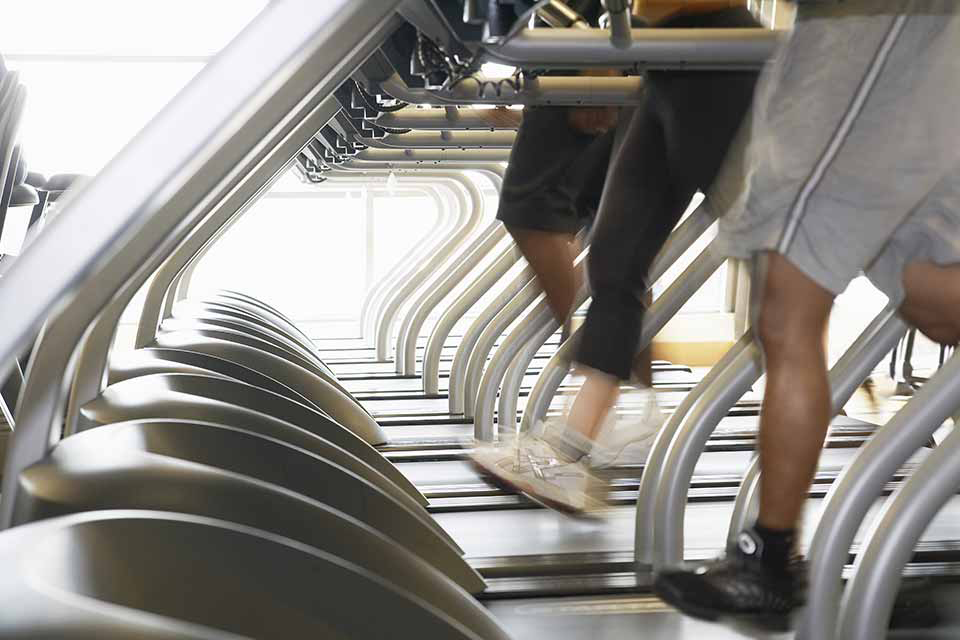

Training for a Half Marathon on a Treadmill
Half Marathon Training April 20, 2014 admin 2

Table of Contents
Many runners spend part of their time training for a half marathon on a treadmill for a variety of reasons. Training in the winter can often mean sub-zero temperatures and icy roads. Rather than risk frostbite or an injury from slipping on ice, many runners will choose to spend many of their winter training days indoors.
Similarly, if you are a runner who suffers from allergies or if you live in a polluted city, sometimes running indoors is a better alternative to an outdoor run.
Beginners can use treadmill training to quickly get into basic running shape in the friendly confines of the gym. Treadmill training is a great way to lightly introduce some basic cross-training, like lifting weights, into your routine.
Note: are you a beginning runner? Check out our From Couch to Course training guide for first-time half-marathoners.
Many advanced runners use treadmills because of the many training benefits treadmills can provide. Treadmills provide more cushioning and aren’t as hard on your joints as many outdoor surfaces. The softer running surface of a treadmill can help prevent common injuries caused from the intense repetitive pounding on pavement.

Treadmills can also help runners improve their pace by providing a controlled environment. Many world class runners train partially on treadmills because treadmills force you to hit time-specific mile repeats.
Whatever your reason is for training for a half marathon on a treadmill, don’t be worried that your treadmill training will not propel you to your ultimate goal. Even though treadmills may not be a perfect substitute for training outdoors, they can be an effective training tool and can help you reach the half marathon finish line with a personal best time.
Tips for Training for a Half Marathon on a Treadmill
Before racing a half marathon, many runners choose to follow a training plan to help them reach the fitness levels required to run 13.1 miles at the pace they want. Most training plans have several three to six mile maintenance runs and one long run each week. All of these can be accomplished indoors but there are several tips to keep in mind.
Pacing: It is important to consider your pace before each run. The treadmill is extremely handy in this case because it forces you to run at your pre-chosen pace. For example, if you want to train at a 10 minute mile pace, the treadmill can be set to a speed of 6 miles per hour and you will have to run a 10 minute mile. For beginner runners, treadmills are especially useful to demonstrate how different paces feel and to help beginner runners choose a half marathon pace that is right for them.
Incline Variation: It is also important to mimic outdoor conditions when running on a treadmill. Many people are tempted to leave the treadmill at a 0 percent incline, but road conditions are never completely flat. There is always some variation in the terrain of an outdoors course and it is important to mimic such fluctuations.
Nearly all treadmills have an incline feature and most treadmills can incline at least up to 10 percent. When running on a treadmill, it is good to vary the incline every once in a while to simulate hilly terrain. Some treadmills have pre-programed runs that involve some hill work and the treadmill will adjust automatically to simulate hills.
If you don’t vary the incline, not only will you find it difficult to switch to running outdoors, but you also might find it harder to meet your fitness goals. By constantly running on a flat surface, especially if you always run at the same pace, you stress the same muscles in the same way every time you get on the treadmill. By changing the incline, you also change the way your muscles are being worked out, which will make your body stronger over time.
Compensate for lack of wind resistance: When running outdoors, you are almost certain to encounter some sort of wind resistance. If you are training indoors, this wind resistance drops and the paces you run on a treadmill are easier than they would be if you were running outdoors.
To compensate for this lack of wind resistance, trainers recommend increasing the incline to 1 or 1.5 percent throughout your entire run. This slight constant incline will keep your indoor pace similar to your outdoor pace, but is also low enough to help runners easily adapt to this slight change.
Recommended Treadmill Workouts for Half Marathon Training
There three main types of workouts you should do on the treadmill when preparing for a half marathon. The three types of training are:
- Tempo Runs
- Interval Training
- Steady State Training
- Pyramid Training
Tempo Runs
Most training plans for a half marathon include several maintenance runs each week that usually range between 3 and 6 miles. Many runners like to do these runs at a specific pace to help boost their cardio capabilities and overall fitness.
The treadmill is a great companion for these maintenance runs because it is possible to consistently hit your target workout pace based on pre-set programming. Also, if you don’t have to worry about external factors like bad weather or stopping at traffic lights, it is easier to concentrate fully on your target pace and speed.
Interval Training
For many first time half marathon competitors, the most important thing is crossing the finishing line. However, many seasoned half marathon runners as well as some first timers also have a goal of achieving a certain finish time. Interval training is key to increasing your speed and getting you to the finish line at a faster time.
Running at a slow and steady pace only exercises certain muscles, so fast interval runs help develop other muscles, which help you to run faster. Treadmills are a great tool to help runners do interval training.
Some treadmills have pre-set interval runs which will automatically adjust your speed. If an interval workout is not already programmed, it is easy to do interval runs just by varying the speed of the treadmill and keeping track of distance ran.
Steady State Training
With this type of training you will choose a speed for the treadmill and stick to that speed for the full training session. Start off by choosing a pace where you can run 2-3 miles without taking a break. Once you can do this, increase the speed during your next training session and see if you can get 2-3 miles again without a break. Every couple of weeks add a mile or two to increase the distance you are running.
Pyramid Training
Pyramid training is very similar to interval training but there are some slight variations. before you start doing pyramid training (or interval training) make sure you get warmed up. Start off by running hard for two minutes, followed by a two minute jog. Now run hard for three minutes, but keep the two minute jog.
Then run hard for three minutes, and jog for two minutes. Do this all the way up to a hard run of 5 minutes, and then work your way back down to 2 minutes. Only do this type of training once per week because it is very demanding on the body.
Adding Outdoor Runs to your Treadmill Half Marathon Training
There are many runners who have trained for their half marathons entirely on the treadmill. It is certainly possible to never run outside before race day, but most experts agree that if you’re predominantly training for a half marathon on a treadmill, at least a handful of runs should be done outside.
The conditions runners face on a treadmill are very different from the conditions runners face outside. If runners become dependent on the indoor running conditions, it will be much harder to run outside on race day and runners used to the treadmill will have a higher risk of injury when running outside on race day.
People’s running stride changes when running on a treadmill compared to running outside. Specifically, the propulsion of the treadmill belt helps lift your leg making less work for your hamstrings. Outside, however, your hamstring needs to work hard to finish the stride cycle. If you rely solely on the treadmill for training, once you get outside for race day, your hamstrings might not be developed enough to allow you to easily run 13.1 miles on outdoor terrain.
Also, on a treadmill, the terrain is even and constant with no obstacles in the path. If you become accustomed to running on a treadmill, your body will expect a constant and smooth terrain. In addition, when running on a treadmill, your ankle does not have the chance to develop and strengthen to stabilize itself on uneven terrain.
If you switch suddenly to running outside, your chance of a misstep on an obstacle like a crack, rock, or curb becomes much higher. If your ankle isn’t accustomed to such obstacles, your chance of injury is much higher.
If you plan to spend a lot of time training for a half marathon on a treadmill, it is best to augment your treadmill runs with occasional outdoors run. If it is impossible to get outdoors, then runners should augment their running with cross training that specifically strengthens the ankle and the hamstrings.
Looking for some more treadmill training tips? Take a look at this video from Expert Village that makes additional treadmill training tips for long distance runners.
Frequently Asked Questions About Training for a Half Marathon on a Treadmill
Can I train for a half marathon on a treadmill?
Absolutely! Treadmills can be a valuable tool for half marathon training. They provide a controlled environment and allow you to maintain a consistent pace. Use the incline feature to simulate outdoor conditions and adjust the speed to match your training goals. While treadmill running lacks some of the outdoor elements, it can still help you build endurance, improve your cardiovascular fitness, and get you race-ready.
Is it okay to do long runs on the treadmill?
Yes, it’s perfectly okay to do long runs on the treadmill. In fact, it can be a convenient option, especially during extreme weather conditions or when outdoor routes are limited. Prepare mentally by setting up entertainment or music, and adjust the incline periodically to mimic outdoor terrain. Stay hydrated, maintain good form, and break the monotony by incorporating intervals or varying the pace. The treadmill can be your long run buddy when circumstances demand it.
Can I do marathon training on a treadmill?
While training for a marathon on a treadmill is possible, it’s generally recommended to incorporate outdoor running as much as possible to acclimate to race conditions. However, the treadmill can still play a valuable role in your training plan. Utilize it for specific workouts like tempo runs, speed intervals, or hill training. Combine treadmill sessions with outdoor runs to strike a balance between convenience and race preparation.
How do you train on a treadmill hill for a half marathon?
Training for a half marathon on a treadmill with an emphasis on hill work is indeed possible. Most treadmills offer an incline feature that allows you to simulate hill training. Begin by gradually increasing the incline to mimic uphill sections of your race course. Maintain good form, engage your core, and use your arms to drive your effort. Vary the incline levels and duration to challenge yourself. Remember, though, that incorporating outdoor hill training is beneficial to adapt to real-world conditions. So, mix it up and conquer those hills on and off the treadmill!

Gym Runner
January 25, 2015 #1 AuthorSome good tips here. I love doing short runs in the gym when it’s cold outside. It’s no fun to run in the snow and ice out on the roads.